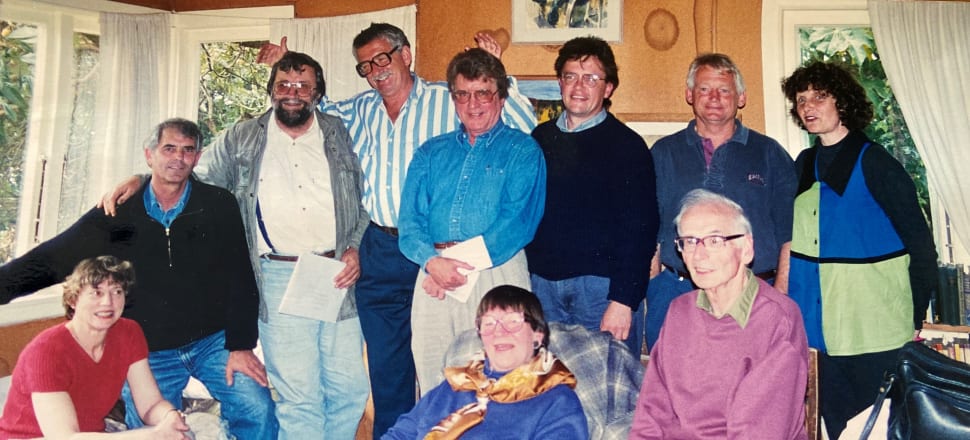
Intimations of mortality at a shack on the North Shore
Hanging on a browning wall of Pinex in a house at 14 Esmonde Road, Takapuna, is a framed photograph. Taken in 1996 after an afternoon meeting of the Frank Sargeson Trust, the photo shows 10 men and women, all Trust members.
The Trust was established in 1986, subsequent to the death of New Zealand writer, Frank Sargeson (1903-1982). Its aims were to preserve Sargeson’s Takapuna house as a literary museum, to promote Sargeson’s writing and to commemorate him by establishing a literary fellowship to support other New Zealand writers. All these aims have been realised.
The Davey family of Hamilton, Frank’s parents, had owned a plot of land in Esmonde Road for many years. In 1931, Frank changed his surname to Sargeson and, determined to become a full-time writer, moved into a hut on the property. He lived there, self-sufficiently, until the mid-1940s. When the hut became uninhabitable, in 1948 Frank moved into a new house, designed by his Jewish refugee friend, Hungarian George Haydn. It is on a wall of that house that the group photograph hangs.
In the photograph, seated at the front of the group, is Christine Cole Catley, Sargeson’s close friend, literary executor and beneficiary. Other Trust members in the photograph are writers Michael King, Kevin Ireland, Dennis McEldowney and myself.
Late last year I attended a meeting at the Sargeson house to select the recipients of the Grimshaw Sargeson Trust Writers’ Fellowship for 2023. Law firm Grimshaw & Co now sponsors the fellowship, succeeding another legal firm Buddle Findlay, who were the sponsors from 1997 to 2010. The generosity of both these firms has supported many writers over the years, such as Emily Perkins, Toa Fraser, Fiona Samuel, Karyn Hay, David Lyndon Brown, Paula Morris, Diana Wichtel, and Sue Orr; the two recipients of the 2023 Fellowship are short story writer Evena Belich, and Kelly Ana Morey, who will work on her sixth novel, Soft Bones, about the everyday lives of five generations of Māori women.
As I sat in the front room at 14 Esmonde Road with the other members of the selection committee, my eyes kept returning to that 1996 photograph, high up on the wall. The 10 people in the photo are all laughing, relishing some witty comment by the person wielding the camera, whose identity I cannot recall. But what struck me now was the realisation that, 27 years on, half the people in the group are dead: Christine Cole Catley, Michael King, Stephen Stratford, Gordon McLauchlan and Dennis McEldowney.
The business of the meeting over, the 2003 Grimshaw Sargeson Fellows duly chosen, the selection committee relaxed over food, drink and conversation. Fittingly, as Sargeson’s house was the venue for many social gatherings over the years, while the writer was alive and after his death. Today was a hot, early summer afternoon and the company was convivial. There were stuffed eggs, muffins, fruit juice and wine. Food and drink were very much a part of Sargeson’s social life (although his own preferred tipple, Lemora lemon wine, was a taste that few others shared).
I imagined the spirit of Sargeson looking down on the house that was his home for 74 years, nodding his approval at the proceedings below. While just a few metres away relentless lines of traffic streamed past along Esmonde Road. An unsealed, tranquil cul-de-sac when Sargeson first lived here, the road is now a de facto motorway, racing vehicles to Auckland’s harbour bridge.
I kept staring at that photograph. Two people in it are at today’s meeting; librarian Helen Woodhouse and myself. Other attendees include Catherine Chidgey and Charlotte Grimshaw, past recipients of the Sargeson Fellowship. Both used it to impel their glittering literary careers. The firm of Charlotte’s lawyer husband Paul Grimshaw now sponsors the Fellowship.
No number of books published can forestall the death of their author. We all must die, some people far too soon, some not soon enough
Still gazing at the photograph, I was unable to prevent myself dwelling on the five lost members. Memories of them kept rushing back. All had been not only fellow authors, but friends too.
Historian Michael King was a founding member of the Sargeson Trust and Sargeson’s biographer. He was the author of a number of fine books, including his prize-winning biography of Janet Frame, Wrestling With The Angel (2000) and the best-selling Penguin History of New Zealand (2003). Michael and his wife Maria died in a car crash in 2004.
Dame Christine Cole Catley was a wonderfully indomitable woman. Her first husband, writer John Reece Cole, had been a close friend and literary colleague of Frank Sargeson’s. Christine founded a publishing company, Cape Catley, which produced many works of fiction and non-fiction. As Sargeson’s beneficiary, she inherited the property at 14 Esmonde Road and his literary estate. Before his death, Frank urged her to sell the estate and, "Go on a cruise, Chris." Instead, selflessly, she used the sale of part of the Takapuna property to establish the Sargeson Literary Fellowship. The benefits accruing to New Zealand literature have been incalculable. She died in 2011.
Dennis McEldowney was for many years editor at the Auckland University Press. He was also a memoirist. His book The World Regained (1957) was the moving account of his overcoming the physical disability of being born a ‘blue baby’. As an editor, Dennis was meticulous, and he and Sargeson had a mutually respectful relationship. An outward frailty concealed his inner physical and moral strength. After recovering miraculously from a serious illness, Dennis died in 2003.
Gordon McLauchlan was a journalist and media presenter, author of The Passionless People (1976), who also fronted a TVNZ’s arts programme, Kaleidoscope. As part of its series profiling New Zealand writers, in 1980 Gordon interviewed Sargeson, at 14 Esmonde Road and other locations on Auckland’s North Shore. The resulting programme comprised an invaluable record of the writer’s life. Supremely self-confident, Gordon’s dogmatic views and lack of sensibility prevented his becoming what he really wanted to be, a fiction writer. But he remained a witty and astute social commentator. Gordon died in 2020, aged 89.
The sudden death of editor Stephen Stratford in 2021, at the age of 68, shocked us all. He brought to the Sargeson Trust unerring literary judgments, honed from his years working at the Listener and Metro, and as founding editor of the literary magazine, Quote Unquote, where his loyal deputy editor was poet Kevin Ireland. Stephen was a brilliant editor who worked with me on several books, and in the process taught me a great deal about writing. Aware that he lacked the necessary motivation to write fiction, instead he applied his expert knowledge of written English to assist those who could. Literally dozens of writers from all parts of New Zealand benefited from his expertise. Stephen’s premature death still affects all those who had the privilege of working alongside him.
So, five of those in that 1996 photograph have gone forever. This inevitably raised the question of a writer’s mortality. No number of books published can forestall the death of their author. We all must die, some people far too soon, some not soon enough. Woody Allen commented on this subject: "I don’t want to achieve immortality through my art, I want to achieve immortality through not dying." There is no finer account of a writer’s decline and death than that of his anti-hero, writer Logan Mountstuart in the William Boyd novel, Any Human Heart (2002). I recently reread this novel and again found novelist Mountstuart’s life and demise almost unbearably moving.
Photographs of actresses famed for their beauty as well as their acting talent have been posted recently on the internet. Vivien Leigh, Hedy Lamarr, Audrey Hepburn, Elizabeth Taylor, Raquel Welsh, Sophia Loren et al. Some of the photographs were taken at the height of the actresses’ gorgeousness. Their beauty is startling: flawless complexions, lustrous hair and, especially, their beautifully eloquent eyes. On this subject, Frank Sargeson himself once commented, about a woman he knew: "How well she understood that her eyes were not just for seeing with."
The internet photos then quickly morph, and decades of life melt in seconds. Look now at the actresses’ photos and flinch at the cruel reality that there is nothing as transient as physical beauty. Those once-beautiful faces become seamed, then hollow. Hair recedes and thins, the once-beguiling eyes become sunken and sorrowful. And it’s not just the women whose beauty quickly dissolves. The contrast between the almost impossibly handsome Marlon Brando in the 1951 movie A Streetcar Named Desire and the morbidly obese mumbler he turned into not many years later is sobering.
Wandering through the house at 14 Esmonde Road, I study the other photos pinned to the walls. They capture many prominent writers enjoying themselves at social functions at the house during the 1980s and 90s: Christine Cole Catley in fancy dress, Maurice Shadbolt (who didn’t even like Frank) puffing on his pipe, Janet Frame doing a joyful jig, Michael King making a speech, Dick Scott, Nigel Cox and Gordon McLachlan, listening to it. And all now dead.
He was clearly not long for this world. But he smiled, held out a shaking hand, then said: “Graeme … don’t … get … old …”
Another photograph shows the flushed but smiling face of a bald, elderly man. This was Bill Mitchell, a frequent visitor to Frank’s. A former secondary school headmaster, he was also an accomplished linguist and grammarian who was fond of exhibiting his language skills. Frank found Bill’s company sometimes trying, while respecting the fact that he was highly educated and very well-read.
In about 1997, I had a ring from Bill’s wife, Margaret, to say that he was very ill. I visited him at his home in the North Shore suburb of Belmont (one of Bill’s favourite Shakespearean quotes was one from The Merchant of Venice, referring to Portia. As he left Sargeson’s house, Bill would inevitably declaim, “In Belmont is a lady richly left”). Now bedridden, Bill was clearly not long for this world. But he smiled, held out a shaking hand, then said: “Graeme … don’t … get … old …”
Ageing. Like shit, it happens. And nothing can stop it, it sneaks up all of us and wreaks its damage. This year I will be the same age as Frank when he died.
Also pinned to the walls at 14 Esmonde Road are some Sargeson memorabilia: Frank’s shopping lists, notes to friends, a Chinese takeaway menu. There are sketches of Sargeson drawn by his artist friend Anthony Stones, a photo of Frank with John Reece Cole, and one of Frank with his beloved companion, Harry Doyle.
All these people are captured as they were, late in the last century, late in the last millennium, and all are embalmed by time. The Sargeson house is, among many other things, a time capsule.
And for me, the most poignant photo on the wall of the Sargeson house is the 1996 one of that group of trustees. The five of the 10 still alive are former editor Elizabeth Caffin, poet and memoirist Kevin Ireland, retired librarian Helen Woodhouse, trust treasurer Martin Bailey and myself.
The rest have passed into history. But what a literary legacy they left us.
A sign outside the house at 14 Esmonde Road, Takapuna states: Frank Sargeson (1903-1982) lived at this address from 1931 until his death. Here he wrote all his best-known short stories and novels, grew vegetables and entertained friends and fellow writers. Here a truly New Zealand literature had its beginnings. People wishing to visit the Sargeson House can obtain a key from the Takapuna Public Library (09 890 4924.)







